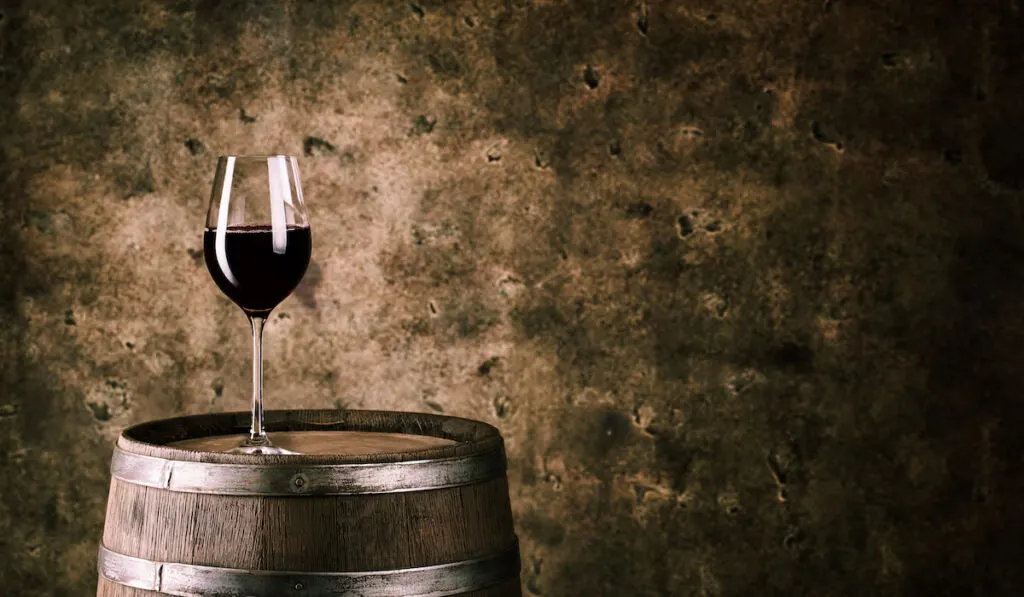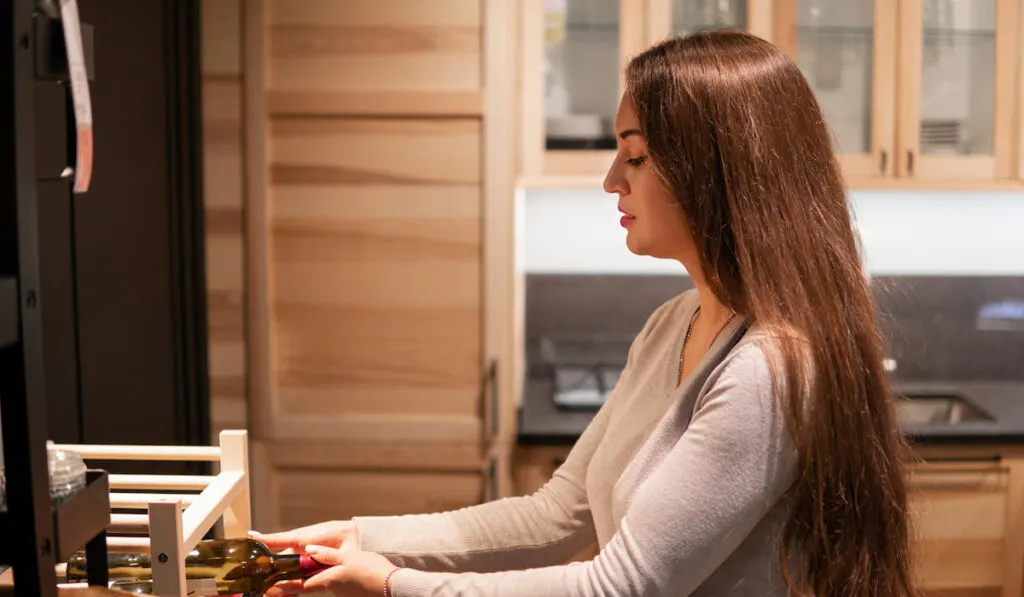You finally decide to open that bottle of wine you were saving for a special occasion. You have a couple glasses but decide to save the rest for another day. Unfortunately, that day only comes up weeks later, so you’re left feeling unsure about whether you can still drink it.
You can tell if your wine is undrinkable in a few ways. Below are nine indications that your wine is bad.

Table of Contents
Nine Ways to Tell If Your Wine Is Bad
When all you want is a glass of wine but you aren’t sure if it’s bad, check for these tell-tale signs.
1. It Has Tiny Bubbles But Isn’t A Sparkling Wine
Sometimes a second fermentation takes place when you leave a bottle of wine for too long. This happens more to opened wines far more than unopened ones.
The second fermentation process is unintentional and causes the wine to carbonate. Tiny bubbles begin to appear, making it look like sparkling wine.
You may experience this problem if you have a faulty wine, but more commonly from leaving it open for too long.
2. It Has A Strange Smell like Nail Polish or Vinegar
You might re-open your bottle of wine and notice a strange smell. Something similar to vinegar or nail polish.
If you get a whiff of that when you open your bottle of wine, it could mean that the oxidation or second fermentation process started. That’s when you know your wine is bad.
Wines that are open for too long can begin to develop a sharp or sour smell. The aromas change when heat and oxygen trigger chemical reactions in the wine.
Bacterias produce acetic acid and acetaldehyde, which then creates odorous fumes that leave the bottle when you open it again.
3. Sometimes It Smells Like Cork

Cork taint is the most common reason a bottle of wine goes bad. This usually happens when winemakers use faulty corks. It’s usually a chemical compound flaw that causes the cork to disintegrate.
Cork taint has a few levels, so the smell might be faint or overwhelming. Many describe it as a wet dog smell with a strong hint of corkboard.
You simply can’t drink a bottle of wine with cork taint. You must throw it out. Bacteria start to form and can cause food poisoning.
4. It Has a the Stench of Rotten Eggs
Sometimes a build-up of sulfur dioxide occurs.
Sulfites are welcome when they are in balance because they moderate the oxidation process. Too much, and you’re left with a bottle of wine that has a pungent rotten egg smell.
5. The Wine Smells Like Cooked Cabbage or Burnt Rubber
You won’t come across this problem often, if at all, but it’s worth noting that wine sometimes smells like cooked cabbage or burnt rubber.
This happens in faulty wine. During the winemaking process, unwanted sulfurs develop and remain in the bottle. The result is a wine with an unpleasant taste.
Rather drink a different bottle of wine if you notice these smells.
6. It Tastes Like Fruit In the Worst Way

Heat and sunlight almost cook your wine, hence the reason why it’s so important to store it in a cool, dark place.
The wine begins to taste like overbaked or oversweet fruit. It can sometimes develop a waxy, peanut, or stewed flavor that’s not horrible but not quite right either.
The best way to prevent your wine from going bad is to limit its exposure to heat and oxygen. Close it as soon as you’re done pouring and put it back in its place. This can often help extend the life of your wine.
Storing your wine in the fridge works wonders. Oxygen moves more slowly in cooler places, so keeping wine in the fridge can slow the oxidation process.
Decanting your wine into a smaller vessel also helps. You can even try pumps or argon sprays to keep the oxygen out of your wine. It might only last a day or two longer, but it’s better than having to throw the whole bottle out.
7. It Has a Cloudy Look
Some wines start cloudy, so you’re likely to rely on the smell and taste to determine if it is bad. When your clear wines begin to cloud, they might be bad.
Oxygen and wine just don’t seem to mix. Your wine begins to cloud when it’s exposed to the air for too long. It’s an indication that yeast and bacteria are growing.
You shouldn’t drink cloudy wine as it can cause food poisoning.
8. It Looks Brownish
Like with fruit, wines begin to brown when they come into contact with oxygen. The oxidation process turns the wine a darker brown.
Red wine will turn from a bright red to a darker purple. It’s almost imperceptible, but you will notice it if you look carefully.
You’ll notice this happens in both red and white wine when you age it. If you notice that a wine you’re trying to age turns brown early, it could mean the oxidation process began.
Try an experiment and watch how the color of wine changes when you leave it open. Set it aside and watch as it oxidizes.
9. If You Have Leakage or Cork In Your Wine, It’s Gone Bad

You might notice some leakage started appearing. This could indicate a bad cork or that the bottle wasn’t recorked properly after opening.
In this case, the wine is exposed to oxygen and might develop a strange look, taste, or smell.
Faulty vs. Flawed Wine – What’s the Difference?
Faulty and flawed wines aren’t cut from the same cloth. A fine line divides the two, but there are a few main differences between them.
Faulty wine starts when there is an issue during the winemaking or fermentation process. Faults often make it undrinkable. You’re unlikely to purchase faulty wine as winemakers do thorough inspections to ensure their products are of the highest quality.
Flawed wine differs in that it usually comes down to personal taste. Flaws happen when minor changes occur to the wine itself. The reasons vary from improperly stored wine to leaving the bottle open after you finish pouring a glass.
What Happens If You Drink Wine That’s Gone Bad?
Overindulging in your favorite Merlot often leaves you feeling sick, like with most alcohol. Moderation is always the trick.
The same applies to bad wine. If you consume a small amount, you should be all right, but large quantities can cause food poisoning.
Wine commonly turns to vinegar when it goes bad. The oxidation process happens when the wine is left open for too long. It can also happen if you have a faulty cork that allowed air to enter the bottle.

Can Drinking Bad Wine Make You Sick?
Drinking vinegared wine won’t cause your body much harm, but it won’t taste pleasant. The issue occurs when bad wine develops microbes that cause food poisoning. The symptoms of that include:
- Cramps in your stomach
- Diarrhea
- Vomiting
- Dehydration
- Fever
If you drank bad wine and have these symptoms, visit a doctor. It’s not common for people to develop food poisoning from bad wine.
Why? Because you have to consume a large amount, and the pungent smell that permeates the air when you open a bad bottle of wine will leave you running to open the windows.
How Long Does Wine Last in the Bottle?
The type of wine and whether it’s open or not impacts how long wine can last in the bottle.
1. Unopened Wine
Properly storing your wine is crucial if you truly want to preserve it. You should usually keep it on its side in a cool, dark place. This prevents the cork from drying out.
You can keep the following wines past their expiration date for a certain amount of time:
- Fortified Wines – Decades
- Vintage Sparkling Wine – Five to ten years
- General Sparkling Wine – Three to four years
- Red Wine – Two to three years
- Rosé – One to two years
- White Wine – One to two years

Your wines will only last this long if they have no faults and you store them correctly.
2. Opened Wine
Opened wine doesn’t last for as long as you might think. Again, it all depends on the type of wine and how much exposure it had to the elements.
- Fortified Wine – One to three weeks
- Red Wine – Three to six days
- Rosé – Three to five days
- White wine – Three to five days
- Sparkling wine – One to two days
Note how they almost all last for less than a week. Only fortified wines will last more than two weeks. Keep track of the day you open your wines to prevent drinking bad wine.
Conclusion
Wine is one of the greatest human creations, but when it goes bad, it’s not enjoyable for anyone. Be sure to look out for these nine signs that your wine is off. You might not notice all nine but rather a combination of a few.
Store your wine correctly and limit its exposure to oxygen so you can enjoy it for a few days longer.
Resources
- https://www.insider.com/signs-that-your-wine-has-gone-bad-2016-7
- https://winefolly.com/tips/how-to-tell-if-wine-has-gone-bad/
- https://www.cookinglight.com/cooking-101/how-to-tell-if-wine-has-gone-bad
- https://www.medicalnewstoday.com/articles/how-long-does-wine-last
- https://wineonmytime.com/what-happens-if-you-drink-bad-wine/
